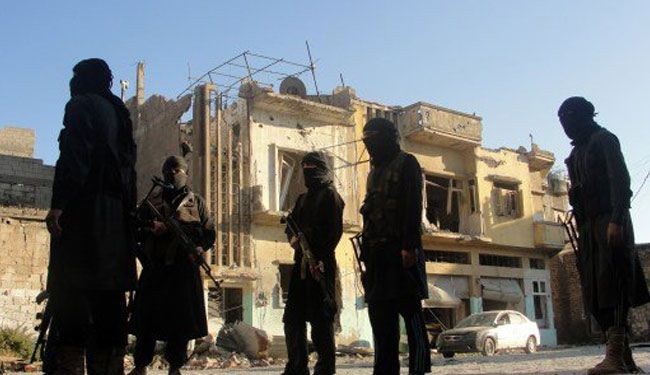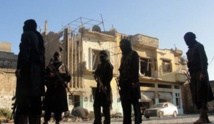Unshaven, pale and gaunt, he has found refuge with his wife and seven children at the Zeinab al-Haliyeh school in Tadamun, a southeastern district of the Syrian capital held by the army.
"I saw severed heads. They killed children in front of their parents. We were terrorised," he said.
"We had heard of their cruelty from the television, but when we saw it ourselves... I can tell you, their reputation is well-deserved," the 55-year-old said.
The school is currently home to 98 displaced people, among them 40 children, who have been put up in three classrooms.
The usual occupants, schoolchildren, have been evacuated temporarily from rooms where mattresses and bedding now blanket the floor.
"I left my house which was the only thing I had. My family lived on rations supplied by UNRWA," the United Nations agency that looks after Palestinian refugees, the former caretaker said.
Anwar Abdel Hadi, a Palestine Liberation Organisation official in Damascus, said 500 families, or about 2,500 people, fled Yarmuk before IS fighters attacked the camp on Wednesday.
Before the assault, there were around 18,000 people in Yarmuk in a southern neighbourhood of the Syrian capital.
Yarmuk was once a thriving district housing 160,000 Palestinian refugees and Syrians. But that was before it too was caught up in the widespread civil unrest which erupted in 2011.
In late December 2012, Yarmuk -- just seven kilometres (four miles) from central Damascus -- became a battlefield between pro- and anti-government forces before a merciless siege began.
The camp has been encircled for more than a year, but is now reported to be almost completely under the control of IS and Al-Qaeda's local affiliate, Al-Nusra Front.
- 'Playing football with heads' -
Residents who fled the advancing jihadists last week have been put up in regime-held areas nearby.
According to Britain-based monitor the Syrian Observatory for Human Rights, nearly 200 people had died in Yarmuk from malnutrition and lack of medicines before Wednesday's assault.
"In Palestine Street, I saw two members of Daesh playing with a severed head as if it was a football," said 16-year-old Amjad Yaaqub, referring to IS by their Arabic acronym.
Wearing a baseball cap sideways, rapper-style, the youth has a swollen eye and chin.
"Daesh came to my home looking for my brother who's in the Palestinian Popular Committees. They beat me until I passed out and left me for dead," he said.
At the entrance to the school, Umm Usama chatted with fellow refugees who had got out.
"I left the camp despite myself," said the 40-year-old woman who had lived in Yarmuk for 17 years.
"I'd stayed on despite the bombings and famine. It was terrible, we ate grass, but at least I was at home.
"Daesh's arrival meant destruction and massacre. Their behaviour's not human and their religion is not ours," added the thin woman with sunken eyes.
Men lie around on mattresses as women gather in small groups, smoking cigarettes and drinking fruit juice as children run around the room.
"Everything changed when IS arrived. Before that we didn't fear death, because if there was fighting, the rebels made sure the civilians got to shelters," said Abir, a 47-year-old woman who was born and raised in Yarmuk.
There are no suitcases to be seen in the classrooms -- the families had to leave so quickly there was no time to pack anything.
"I left without bringing any belongings. My husband wasn't able to join me. I walked out hugging the walls so snipers couldn't see me," said 19-year-old Nadia, nursing her two-month-old baby.
------------------------------------------------------------------------------------------------------
"I saw severed heads. They killed children in front of their parents. We were terrorised," he said.
"We had heard of their cruelty from the television, but when we saw it ourselves... I can tell you, their reputation is well-deserved," the 55-year-old said.
The school is currently home to 98 displaced people, among them 40 children, who have been put up in three classrooms.
The usual occupants, schoolchildren, have been evacuated temporarily from rooms where mattresses and bedding now blanket the floor.
"I left my house which was the only thing I had. My family lived on rations supplied by UNRWA," the United Nations agency that looks after Palestinian refugees, the former caretaker said.
Anwar Abdel Hadi, a Palestine Liberation Organisation official in Damascus, said 500 families, or about 2,500 people, fled Yarmuk before IS fighters attacked the camp on Wednesday.
Before the assault, there were around 18,000 people in Yarmuk in a southern neighbourhood of the Syrian capital.
Yarmuk was once a thriving district housing 160,000 Palestinian refugees and Syrians. But that was before it too was caught up in the widespread civil unrest which erupted in 2011.
In late December 2012, Yarmuk -- just seven kilometres (four miles) from central Damascus -- became a battlefield between pro- and anti-government forces before a merciless siege began.
The camp has been encircled for more than a year, but is now reported to be almost completely under the control of IS and Al-Qaeda's local affiliate, Al-Nusra Front.
- 'Playing football with heads' -
Residents who fled the advancing jihadists last week have been put up in regime-held areas nearby.
According to Britain-based monitor the Syrian Observatory for Human Rights, nearly 200 people had died in Yarmuk from malnutrition and lack of medicines before Wednesday's assault.
"In Palestine Street, I saw two members of Daesh playing with a severed head as if it was a football," said 16-year-old Amjad Yaaqub, referring to IS by their Arabic acronym.
Wearing a baseball cap sideways, rapper-style, the youth has a swollen eye and chin.
"Daesh came to my home looking for my brother who's in the Palestinian Popular Committees. They beat me until I passed out and left me for dead," he said.
At the entrance to the school, Umm Usama chatted with fellow refugees who had got out.
"I left the camp despite myself," said the 40-year-old woman who had lived in Yarmuk for 17 years.
"I'd stayed on despite the bombings and famine. It was terrible, we ate grass, but at least I was at home.
"Daesh's arrival meant destruction and massacre. Their behaviour's not human and their religion is not ours," added the thin woman with sunken eyes.
Men lie around on mattresses as women gather in small groups, smoking cigarettes and drinking fruit juice as children run around the room.
"Everything changed when IS arrived. Before that we didn't fear death, because if there was fighting, the rebels made sure the civilians got to shelters," said Abir, a 47-year-old woman who was born and raised in Yarmuk.
There are no suitcases to be seen in the classrooms -- the families had to leave so quickly there was no time to pack anything.
"I left without bringing any belongings. My husband wasn't able to join me. I walked out hugging the walls so snipers couldn't see me," said 19-year-old Nadia, nursing her two-month-old baby.
------------------------------------------------------------------------------------------------------









 Home
Home Politics
Politics











